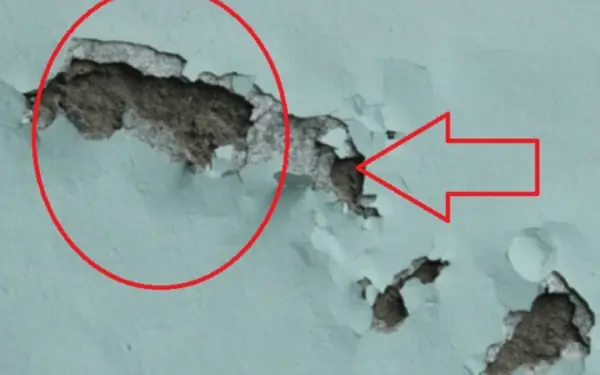
Tips to deal with moldy, peeling walls. Any cost can do it
With the tips below, you will be able to easily handle the peeling and flaking on your walls without needing a worker.
During humid days like today, your walls will easily become damp, peeling and breaking into ugly pieces that are no longer as aesthetically pleasing as before. To handle these peeling and flaking spots, you will have to call a worker and spend a lot of money. But with the tips below, your walls will be clean and smooth as new.
How to deal with mold on walls

Using the brush method
In the humid season, when it drizzles, many houses have mold on their walls. At that time, you can use a brush to clean the mold first. Use a soft cloth dipped in water to wipe the wall, helping to prevent mold from growing. However, note that this method will be effective if the mold has just appeared and the moldy wall area is not too large.
how-to-treat-moldy-wall-stains-3
Using bleach
If your walls are moldy, you can mix bleach with water in a 1:99 ratio and pour it into a spray bottle. Spray the solution onto the wall and leave it for a while for the bleach to work, fading the stains on the wall. Then, you can use a brush to lightly scrub the stains and wipe them clean with a cloth.
If the walls are heavily moldy, you can mix a more concentrated bleach solution, with a bleach to water ratio of 1:20.
This method is suitable for stains that have not yet appeared. For heavily damaged walls, you still need more professional treatment steps such as using sandpaper to smooth the wall, applying a layer of waterproof primer and then applying topcoat.
How to handle peeling and blistering walls
Removing the peeling part and scraping off the putty layer is the first step to handle peeling and blistering walls. Then, smooth and polish the scraped wall with sandpaper. Finally, apply a layer of primer and topcoat.
If the peeling area is large, after scraping it off, wait until the wall is dry before continuing with the treatment steps. During the treatment process, pay attention to applying a layer of waterproof paint to the base of the wall and plastering the cracks on the wall.
wall-wall-peeling-5
Avoid repainting the wall during the rainy season.
In addition, you can use wallpaper or wall coverings. This is a temporary solution for families who do not have electricity to immediately solve the problem of dampness.
To cover mold and peeling spots, you can use PVC plastic or wallpaper. Before pasting, you must scrape off the peeling paint.
This method saves costs and takes a short time to process, but it is only an aesthetic solution and does not solve the root cause of mold.
Methods to prevent moisture in the house
Use a dehumidifier
You can use a dehumidifier to reduce the humidity inside the house.
In addition, using desiccant, activated carbon, cotton, and young charcoal can also help absorb moisture and prevent moisture. You just need to put one of the above ingredients in a small cloth bag, tie it up and place it in every corner of the room to reduce humidity.
Close the door in the winter
When the weather is humid, you should close the doors and windows to avoid the house being "steamy". On dry days, open the doors to ventilate, helping to reduce the amount of moisture in the house.
News in the same category


These 10 Foods May Support Cellular Health: What Research Suggests About Natural Antioxidant Power!

9 Urgent Warning Signs Your Body Is Sending – Ignoring These Could Be Dangerous!

Joint Pain? The Ultimate Guide to Rebuilding Your Joints Naturally: 8 Powerful Fruits You Must Know!

Over 60? 10 Early Dementia Warning Signs You Must NEVER Ignore (Catch Them Before It’s Too Late)

These are the consequences of wearing used…

What Happens to Your Body When You Eat Honey Every Day

What Happens to Your Body When You Eat Spinach Regularly

Daily Aloe Vera Juice Consumption and Improved Thyroid Function in Women with Subclinical Hashimoto’s Hypothyroidism

The Gut–Brain Connection: How Digestive Health Influences Mood and Mental Well-Being

A Complete Guide to Breast Cancer Prevention

What Can Happen When Women Lack Sexual Intimacy?

Tapering Antidepressants: What Strategy Works Best?

The Brainstem and Pain: New Research, New Understanding

Could a Simple Bedtime Drink with Three Common Ingredients Support Your Heart Health?

Between Supplement Hype and Evidence: A Clinical Guide for Informed Use

Current Cardiac Screening Tools Miss Nearly Half of First Heart Attacks, Study Finds

Could Bone Broth Support Healthy Knee Cartilage as You Age?

Top 7 Best Drinks Diabetics Can Enjoy at Night to Support Healthy Blood Sugar Levels!

Papaya Leaves for Hair: A Natural Way to Support Healthier, Shinier Strands
News Post

Top 10 Superfoods That Fight Proteinuria and Give Your Kidneys New Life – Starting in as Little as 7 Days

These 10 Foods May Support Cellular Health: What Research Suggests About Natural Antioxidant Power!

9 Urgent Warning Signs Your Body Is Sending – Ignoring These Could Be Dangerous!

Joint Pain? The Ultimate Guide to Rebuilding Your Joints Naturally: 8 Powerful Fruits You Must Know!

Over 60? 10 Early Dementia Warning Signs You Must NEVER Ignore (Catch Them Before It’s Too Late)

Top 3 Nutrients Seniors Need to Stop Leg Cramps and Restore Strength: Reclaim Your Steady Steps Today!

12 Surprising Potential Benefits of Moringa Seeds You Might Not Hear About – But Research Suggests They’re Worth Knowing!

Discover the Timeless Secret of a 95-Year-Old Chinese Doctor: How He Stays Vibrant and Healthy

Urgent Advisory for New Smart Device Users: What You Need to Know About Privacy and Security

Urgent Warnings Over Smart Devices: What New Owners Need to Know About Privacy and Security

Therapy Dogs in the Courtroom: Bringing Compassion and Healing to the Justice System

Growing Organs from Stem Cells: A Breakthrough That Could Transform Organ Transplantation

California’s Solar Canals: A Dual Solution for Water Conservation and Clean Energy

Limberlost Place: How Canada Is Redefining Skyscrapers with Mass Timber Architecture

These are the consequences of wearing used…

What Happens to Your Body When You Eat Honey Every Day

What Happens to Your Body When You Eat Spinach Regularly

Daily Aloe Vera Juice Consumption and Improved Thyroid Function in Women with Subclinical Hashimoto’s Hypothyroidism

The Gut–Brain Connection: How Digestive Health Influences Mood and Mental Well-Being
